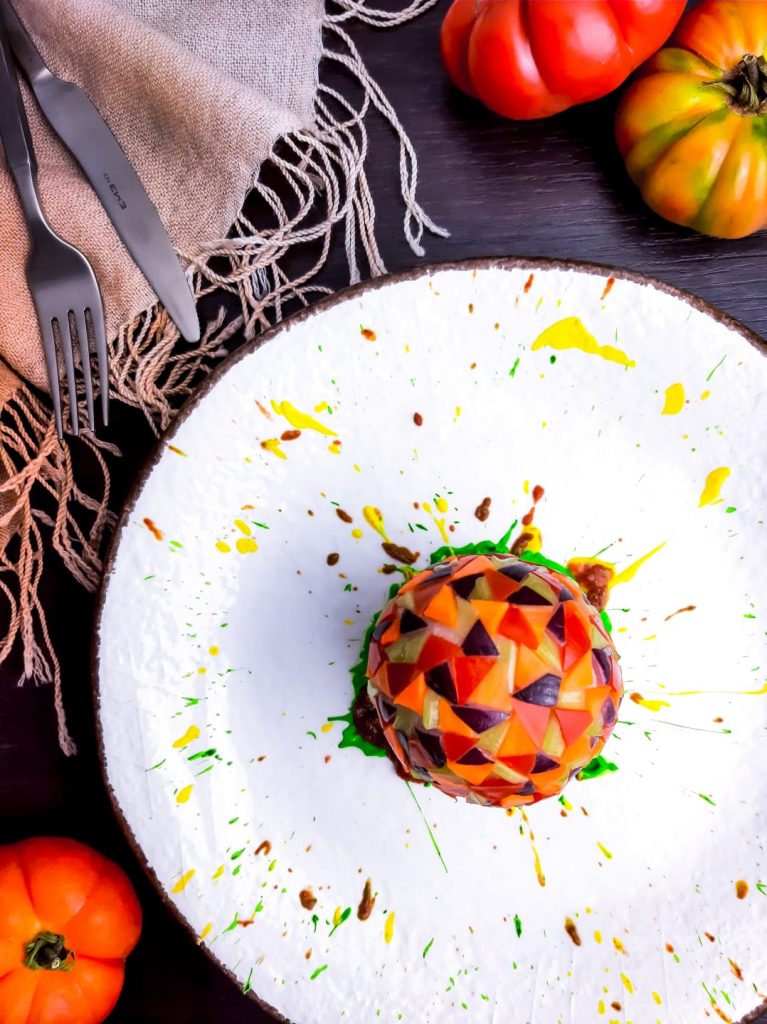La Panzanella è un piatto tipico dell’Italia Centrale, viene consumato da molti secoli ed è molto amato, soprattutto in questo periodo, dove il caldo estivo comincia a farsi sentire come la voglia di cibi freschi e verdure di stagione. La panzanella è un piatto tra i più antichi della nostra tradizione culinaria e sicuramente anche l’origine del suo nome si perde nella notte dei tempi. Nome che deriverebbe dall’unione delle parole pane e zanella, ossia zuppiera.
Scroll down 👇🏼 to read the recipe and history in English.
Altra versione invece farebbe risalire il nome al termine latino panzana, che significava pappa, richiamando quindi la composizione composta con il pane raffermo bagnato ma “pansana”, era anche una bugia ironica, divertente, e chissà se in qualche modo c’entra con la storia di questo piatto o con una versione simile detta “pan lavato” , citata nel XIV secolo da Boccaccio in una novella del Decameron, testo dove pansane, beffe, peripezie e fortune sono tematiche predilette dall’autore, finalizzate ad intrattenere i lettori attraverso il riso e la spensieratezza.
Per certi versi questo piatto è così, spensierato, semplice da preparare, originale e colorato, umile perchè nato dalla tradizione contadina, ma ancora oggi in grado di soddisfare i palati più esigenti nonostante si basi su ingredienti poveri come il pane casareccio e gli ortaggi. La base di questa ricetta è indubbiamente il pane raffermo casareccio, di tipo sciapo, il punto di partenza di questa pietanza, da sempre al centro delle colture e dell’alimentazione italiana.
Il pane era uno dei pochi alimenti facilmente reperibili sia nelle cucine aristocratiche che nelle case dei più poveri e non a caso molti piatti dell’Italia Centrale si sviluppano a partire dal pane. Quello utilizzato nella panzanella deve essere rigorosamente pane raffermo, questo piatto infatti rientra tra quelli di recupero, ovvero piatti consumati con avanzi di cibo. Il pane, indurito dal tempo, veniva bagnato con acqua e aceto così da poterlo sbriciolare e mescolare agli altri ingredienti. Acqua e aceto addirittura erano una miscela utilizzata dai soldati romani in marcia, scelta per le sue elevate proprietà dissetanti. Prepazioni e usanze antichissime quindi, quelle da cui nasce la panzanella, le cui origini sono contese tra contadini e vecchi pescatori, certo è che un piatto così semplice è riuscito ad arrivare sulle tavole delle personalità più importanti ed ha attraversato la storia giungendo fino a noi sotto forma di svariate versioni. Una versione aristocratica fu quella descritta dal Bronzino, pittore della corte medicea, che presenta, oltre al pane, al basilico e alla cipolla tritata, il cetriolo. Questo freschissimo prodotto estivo proveniva dall’India e nel Cinquecento era senza dubbio un ortaggio consumato dalle famiglie più ricche.
Così troviamo scritto nel “Poemetto Della Cipolla” del Bronzino:
…chi vuol trapassar sopra le stelle di melodia v’aggiunga olio e aceto en’tinga il pane e mangi a crepapelle. Una insalata di cipolla trita colla porcellana e cetriuoli vince ogni altro piacer di questa vita.
Un poemetto che in sé descrive tutta la bontà e regalità di questo piatto, che conquista tutti con i suoi pochi ingredienti e la sua semplice prepazione. La semplicità, i prodotti genuini, meritano un grande rispetto da parte di chi si siede a tavola, per questo ho pensato di cucire un abito nuovo ed elegante per questo piatto, una versione ricca, dei giorni nostri, come poteva essere quella del Bronzino di allora, una proposta in chiave gourmet che racchiude tutta la bellezza e la vivacità dei colori di questo piatto, protagonista indiscusso delle estati di oggi e di ieri. Buon appetito.

Panzanella
Ingredienti:
• 220 g di pane raffermo
• 220 g di pomodori
• 50 g di olio extra vergine d’oliva
• 40 g di aceto bianco
• sale q.b
• 100 g di purea di fagioli cannellini
• 100 g di carote
• 100 g di cipolla rossa di tropea
• 100 g di sedano verde
Per la salsa allo zafferano:
• 2 cucchiai di farina
• 100 g di burro
• 10 stimmi di zafferano
• 1 bicchiere di brodo vegetale
• sale q.b
Per la salsa al pomodoro:
• 300 g pomodori
• 1 carota
• ½ costa di sedano
• ½ cipolla rossa piccola
• 1 spicchio d’aglio
• 2 foglie di basilico fresco
Per la salsa al prezzemolo:
• 200 g foglie di prezzemolo
• 1 manciata di sale grosso
• acqua ghiacciata q.b
• olio extravergine di oliva q.b
Procedimento:
Per il cuore della panzanella mescolate in una terrina la purea di fagioli con un goccio d’olio d’oliva e un pizzico di sale e mettete il tutto in una sac a poche. Tagliate quattro fette di pomodoro con spessore di circa 1 cm e conservatele da parte. Per quanto riguarda il rivestimento esterno tagliate il resto dei pomodori a cubetti di 2 millimetri. le carote, il sedano verde e la cipolla. Tagliate il pane a cubetti e mettetelo a marinare con tutti gli elementi e fate riposare per almeno 2 ore. Nel frattempo preparate la salsa alla zafferano, In una pentola fate sciogliere il burro a fuoco lento, unite la farina setacciata e mescolate fino a ottenere un composto omogeneo. Unite a filo il brodo vegetale caldo in cui avrete sciolto gli stimmi di zafferano. Mescolate per ottenere una crema dalla consistenza leggermente densa, regolate di sale e tenete da parte. Ora passate alla salsa di pomodoro, tagliate i pomodori in due e liberateli dai semi, metteteli in una casseruola e accendete il fuoco, aggiungete 1 bicchiere d’acqua e lasciate cuocere a pentola coperta per far ritirare il liquido. Preparate un battuto di cipolla, sedano e carota. Quando il liquido dei pomodori si sarà ritirato, spegnete il fuoco e trasferite i pomodori in una ciotola. Ora scaldate un giro d’olio extravergine d’oliva in una casseruola, aggiungetevi il battuto di verdure preparato in precedenza, lo spicchio d’aglio intero e lasciate cuocere. Nel frattempo frullate i pomodori e uniteli al soffritto con qualche foglia di basilico, sale e lasciate cuocere a fiamma bassa e a casseruola coperta per 30 minuti circa. Se si dovesse asciugare troppo, aggiungete dell’acqua. Trascorso il tempo di cottura e raggiunta la consistenza desiderata potete frullare il tutto, rimuovendo lo spicchio d’aglio, per ottenere una salsa vellutata, regolate di sale e tenete da parte. Per la salsa verde di prezzemolo, staccate le foglie di prezzemolo, mettete a bollire una pentola piccola con acqua e una manciata di sale grosso. Riempite una ciotola capiente con acqua fredda e aggiungete dei cubetti di ghiaccio. Quando l’acqua in pentola giungerà a bollore aggiungete le foglie di prezzemolo bene in immersione, laciatele finchè l’acqua non riprenderà il bollore. Una volta ripreso il bollore togliete la pentola dal fuoco, scolate il prezzemolo e tuffatelo immediatamente nell’acqua ghiacciata. Dopo qualche minuto, con un mestolo forato, togliete le foglie dall’acqua gelata e adagiatele su un foglio di carta da cucina per far loro perdere l’acqua in eccesso. Buttate l’acqua gelata conservandone però mezzo bicchiere. Inserite le foglie di prezzemolo nel bicchiere di un frullatore ad immersione, aggiungete qualche cucchiaio di acqua gelata ed iniziate a frullare. Unite l’olio a filo piano piano, finchè il composto risulterà ben amalgamato e cremoso senza però diventare troppo liquido. Passate la crema ottenuta con un colino a maglie strette, fino ad ottenere una salsa densa e omogenea. Per le sfere di pane distendete un foglio di pellicola, cospargetelo di pane strizzato bene e mettete al centro un ciuffo di crena di cannellini. Richiudete il tutto formando una sfera, togliete la pellicola e fate rotolare la sfera nella restante parte di verdure a cubetti che avete tagliato in precedenza. Per l’impiattamento mettete al centro del piatto un cucchiaio di ognuna delle tre salse e picchiate energicamente con il dorso del cucchiaio stesso così da creare uno schizzo decorativo. Al centro disponete una fetta di pomodoro e sopra di essa appoggiate la sfera, condita con olio extra vergine.
Panzanella
Panzanella is a typical dish of Central Italy that has been consumed for many centuries. It is very popular, especially in this period, where the summer heat begins to be felt together with the desire for fresh foods and seasonal vegetables. The origin of the name Panzanella, one of the oldest dishes of our culinary tradition, is lost in the mists of time. The name seems to derive from the union of the words pane, bread, and zanella, tureen. According to another thesis, the name goes back to the Latin term “panzana”, that recalls the composition of wet. stale bread.
Pansana also means an ironic, funny lie, and who knows if somehow it has to do with the history of this dish or with a similar version called pan lavato, cited in the fourteenth century by Boccaccio in a short story from the Decameron, a text where pansane, mockery, vicissitudes and fortunes are the author’s favorite themes, aimed at entertaining readers through laughter and lightheartedness.
In some ways, this dish is exactly like that: carefree, simple to prepare, original, colorful and humble since it was born from the peasant tradition. However, still today, despite being based on simple ingredients such as homemade bread and vegetables, it satisfies the most demanding palates. Stale homemade bread, unsalted, is undoubtedly the base of this recipe.
Bread has always been at the center of Italian nutrition and one of the few foods readily available in the kitchens of both aristocrats and the poor. It is no coincidence that bread was the basis of many dishes in Central Italy. The one used in the panzanella must be strictly stale; in fact, this dish is basically made from leftovers. The bread, hardened by time, was soaked in water and vinegar so that it could be crumbled and mixed with the other ingredients. The mixture of water and vinegar was also used by Roman soldiers on the march for its high thirst-quenching properties. It is all about ancient preparations and customs whose origins are disputed between farmers and old fishermen. What is certain is that such a simple dish has succeeded in arriving on the tables of the most important figures and has gone throughout history, reaching us in several versions. Bronzino, painter of the Medici court described an aristocratic version of it that, in addition to bread, features basil, chopped onion and cucumber. This last fresh summer vegetable came from India and, in the sixteenth century, was undoubtedly consumed by the wealthiest families.
Thus we find written in Bronzino‘s “Poemetto Della Cipolla” (Little Poem to the Onion):
“… whoever wants to pass the stars in melody should add oil and vinegar to it, dip the bread and eat your heart out. A chopped onion salad with purslane and cucumbers wins every other pleasure in this life. “
The poem well describes all the goodness and royalty of this dish which, with its few ingredients and its simple preparation, conquers everyone. The simplicity and genuine ingredients deserve great respect from those who sit at the table. That’s why I thought of sewing a new and elegant dress for this dish: a rich version of the present day like that of Bronzino from back then: a gourmet proposal that encompasses all the beauty and vivacity of the colors of this dish and undisputed protagonist of today’s and yesterday’s summers. Enjoy your meal!
Panzanella
Ingredients:
• 220 g of stale bread
• 220 g of tomatoes
• 50 g of extra virgin olive oil
• 40 g of white vinegar
• Salt to taste
• 100 g of cannellini bean puree
• 100 g of carrots
• 100 g of red Tropea onion
• 100 g of green celery
For the saffron sauce:
• 2 tablespoons of flour
• 100 g of butter
• 10 stigmas of saffron
• 1 glass of vegetable broth
• Salt to taste
For the tomato sauce:
• 300 g tomatoes
• 1 carrot
• ½ celery stalk
• ½ small red onion
• 1 clove of garlic
• 2 fresh basil leaves
For the parsley sauce:
• 200 g parsley leaves
• 1 handful of coarse salt
• ice-cold water to taste
• extra virgin olive oil to taste
Method:
For the heart of the panzanella, mix the bean purée with a drop of olive oil and a pinch of salt in a bowl and put everything in a sac a poche. Cut four slices of tomato with a thickness of about 1 cm and set aside. As for the outer coating, cut the rest of the tomatoes, carrots, green celery and onion into 2mm cubes. Cut the bread into cubes and put it to marinate with the ingredients and let it rest for at least 2 hours.
Meanwhile, prepare the saffron sauce. In a saucepan, melt the butter over low heat, add the sifted flour and mix until smooth. Add the hot vegetable broth in which you have dissolved the saffron stigmas. Mix to obtain a slightly thick cream; season with salt and set aside.
For the tomato sauce, cut the tomatoes in two and remove the seeds; put them in a saucepan and turn on the heat. Add 1 glass of water and cook in a covered pot to reduce the juice. Chop onion, celery and carrot. When the liquid from the tomatoes has reduced, turn off the heat and transfer the tomatoes to a bowl. Now heat a bit of extra virgin olive oil in a saucepan, add the previously prepared chopped vegetables, the whole clove of garlic and let it cook. In the meantime, blend the tomatoes and add them to the sauté with a few basil leaves and salt and cook over low heat in a covered saucepan for about 30 minutes. If it gets too dry, add water. Once reached the desired consistency, blend everything, removing the clove of garlic, to obtain a velvety sauce; season with salt and set aside.
For the green parsley sauce, remove the parsley leaves, put water to boil in a small pot and add a handful of coarse salt. Fill a large bowl with cold water and add ice cubes. When the water in the pot comes to a boil, add the parsley leaves in immersion and leave them until the water boils again. Once boiling has resumed, remove the pot from the heat, drain the parsley and immediately dip it into the ice water. After a few minutes, with a slotted spoon, remove the leaves from the frozen water and place them on a sheet of kitchen paper to drain. Keep half a glass of the frozen water and throw away the rest. Place the parsley leaves and a few tablespoons of ice water in the glass of an immersion blender and start blending. Add the oil slowly until the mixture results creamy without becoming too liquid. Pass the cream obtained through a narrow mesh sieve, until you get a thick and homogeneous sauce.
For the bread balls, spread a sheet of cling film, sprinkle it with well squeezed bread and place a clump of cannellini cream in the center. Close everything to form a sphere, remove the film and roll the sphere in the remaining diced vegetables that you cut earlier. To serve, place a spoonful of each of the three sauces in the center of the plate and beat vigorously with the back of the spoon to create a decorative sketch. In the center, place a slice of tomato and place the sphere on top of it, seasoned with extra virgin olive oil.
Try these other recipes…
Baccalà alla Ceraiola
Sformato di roveja
Baci di Romeo e Giulietta



